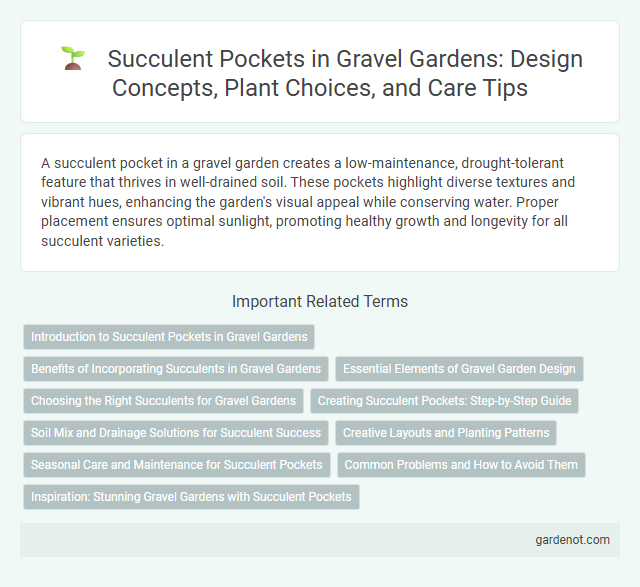A succulent pocket in a gravel garden creates a low-maintenance, drought-tolerant feature that thrives in well-drained soil. These pockets highlight diverse textures and vibrant hues, enhancing the garden's visual appeal while conserving water. Proper placement ensures optimal sunlight, promoting healthy growth and longevity for all succulent varieties.
Introduction to Succulent Pockets in Gravel Gardens
Succulent pockets in gravel gardens create microhabitats that maximize water retention for drought-tolerant plants. These pockets consist of shallow soil depressions filled with nutrient-rich substrates ideal for various succulents like Sempervivum and Sedum. Integrating succulent pockets enhances biodiversity while maintaining the minimalist aesthetic and low-maintenance appeal of gravel landscapes.
Benefits of Incorporating Succulents in Gravel Gardens
Incorporating succulents in gravel gardens enhances water efficiency due to their drought-resistant nature, significantly reducing irrigation needs. Their diverse textures and colors contribute to year-round visual interest and low maintenance requirements, making them ideal for sustainable landscaping. Succulents improve soil stability by preventing erosion, supporting healthier garden ecosystems in gravel settings.
Essential Elements of Gravel Garden Design
Succulent pockets are vital elements in gravel garden design, offering drought-resistant plant options that thrive in well-drained, mineral-rich soil. Incorporating essential features like layered gravel for optimal drainage, heat-retentive stone placement, and strategic spacing enhances succulent growth and visual interest. Properly designed succulent pockets contribute to sustainable, low-maintenance landscapes that conserve water and reduce soil erosion.
Choosing the Right Succulents for Gravel Gardens
Selecting the right succulents for gravel gardens involves prioritizing drought-tolerant species such as Sedum, Echeveria, and Sempervivum, known for their resilience and minimal water requirements. Opt for varieties that thrive in well-drained, gravelly soil to prevent root rot and ensure vibrant growth. Incorporating a mix of textures and colors enhances visual appeal while maintaining low maintenance needs.
Creating Succulent Pockets: Step-by-Step Guide
Creating succulent pockets involves selecting well-draining soil rich in organic matter to ensure proper root growth and moisture retention. Begin by carving small depressions in the gravel garden bed, then gently insert succulent cuttings or offsets into these pockets, securing them with a light layer of soil. Maintain consistent, moderate watering and place the pockets in areas with ample sunlight to promote healthy, thriving succulent growth.
Soil Mix and Drainage Solutions for Succulent Success
A well-draining soil mix is essential for succulent pockets, typically composed of coarse sand, perlite, and a small amount of organic matter to mimic their natural arid environments. Proper drainage solutions include using gravel or small stones at the bottom of the planting pocket to prevent water accumulation and root rot. Ensuring rapid water runoff and aeration in the soil promotes succulent health and long-term growth.
Creative Layouts and Planting Patterns
Succulent pocket designs showcase creative layouts that maximize space efficiency while enhancing visual appeal through varied planting patterns. Incorporating diverse textures and colors, these arrangements create dynamic, low-maintenance garden features ideal for gravel garden settings. Strategic placement of succulents in geometric or organic shapes fosters natural drainage and highlights the unique beauty of each plant.
Seasonal Care and Maintenance for Succulent Pockets
Succulent pockets require minimal seasonal care, thriving in well-drained soil with moderate watering during spring and summer to prevent root rot. Reduce watering significantly in fall and winter, allowing the soil to dry completely to mimic their natural dormant period. Regularly check for pests and remove dead leaves to maintain plant health and aesthetics.
Common Problems and How to Avoid Them
Succulent pockets often face common problems such as root rot, caused by overwatering, and poor drainage due to compacted soil. To avoid these issues, ensure the soil mixture is well-draining, typically a blend of coarse sand, perlite, and cactus potting mix, and water succulents sparingly, allowing the soil to dry completely between waterings. Providing ample sunlight and avoiding overcrowding also helps prevent fungal infections and promotes healthy growth.
Inspiration: Stunning Gravel Gardens with Succulent Pockets
Succulent pockets in gravel gardens create striking focal points with their vibrant textures and drought-resistant qualities. These pockets maximize space by embedding succulents into gravel beds, enhancing both aesthetics and water efficiency. Designers often draw inspiration from desert landscapes, blending diverse succulent species to achieve stunning, low-maintenance garden displays.
Succulent pocket Infographic

 gardenot.com
gardenot.com